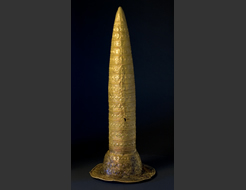|
||||||||||||||||||||||||||||||||
|
|
Museum of: Berlin | |||||||||||||||||||||||||||||||
| Name of the artefact: Berlin Golden Hat | ||||||||||||||||||||||||||||||||
|
The Bronze Age Golden Hat was bought by the Museum for
Pre- and Early History, Berlin in the year 1996. Depending on its fine
state of conservation it could be interpreted as a headdress of a
chieftain or a priest. |
||||||||||||||||||||||||||||||||
|
WHERE IS IT AND MAIN
CHARACTERISTICS |
STATE |
|||||||||||||||||||||||||||||||
|
Department: |
Museum for Pre- and Early
History |
Preservation: |
Very good | |||||||||||||||||||||||||||||
|
Inventory number: |
IIc 6068 |
Restauration: |
Restored | |||||||||||||||||||||||||||||
|
Name of the artefact: |
Berlin Golden Hat |
Completeness: |
Complete | |||||||||||||||||||||||||||||
|
Object type: |
Other |
|||||||||||||||||||||||||||||||
|
Material: |
Gold, Bronze |
|||||||||||||||||||||||||||||||
|
Methof of manufacture: |
Embossed work |
|||||||||||||||||||||||||||||||
|
Decoration
type: |
Stamp |
|||||||||||||||||||||||||||||||
|
Distinctive mark: |
Form of a hat |
|||||||||||||||||||||||||||||||
|
DIMENSIONS |
PERIOD OF USE |
|||||||||||||||||||||||||||||||
|
Length (mm): |
- |
Epoque: |
Bronze Age |
|||||||||||||||||||||||||||||
|
Heigth
(mm): |
745 |
Culture: |
Urnfield culture |
|||||||||||||||||||||||||||||
|
Diameter
(mm): |
100 (calotte) |
Period: |
Hallstatt A-B |
|||||||||||||||||||||||||||||
|
Width (mm): |
- |
Face: |
- |
|||||||||||||||||||||||||||||
|
Thickness (mm): |
0.06 |
Absolute chronology: |
11 - 9 century BC |
|||||||||||||||||||||||||||||
|
Weight
(g): |
490 |
|||||||||||||||||||||||||||||||
DISCOVERY |
||||||||||||||||||||||||||||||||
|
Date: |
Purchased by the museum in
1996 |
Country: |
Unknown |
|||||||||||||||||||||||||||||
|
District: |
Unknown |
Town hall affiliation: |
Unknown |
|||||||||||||||||||||||||||||
|
Village: |
Unknown |
Discovery findspot: |
Unknown |
|||||||||||||||||||||||||||||
|
Condition of discovery: |
Chance Discovery |
Discovery type: |
Other |
|||||||||||||||||||||||||||||
|
ANALYSES – DETERMINATIONS |
FILLED IN BY |
|||||||||||||||||||||||||||||||
|
Type: |
Microsonde; Proton-Induced-X-Ray-Emission
spectros |
Name: |
Dr. Manfred Nawroth |
|||||||||||||||||||||||||||||
|
Laboratory: |
Institute for Metallurgy, TU Berlin;
Laboratoire d |
Institution: |
Museum for Pre- and Early
History |
|||||||||||||||||||||||||||||
|
No./Code: |
- |
Date: |
11/11/2005 |
|||||||||||||||||||||||||||||
|
DEEPENINGS |
||||||||||||||||||||||||||||||||
|
Morphology of the object: |
||||||||||||||||||||||||||||||||
|
The 74,5 cm high Berlin Golden hat was made by a
specialized gold-smith in embossed work. Therefore he used one paper-thin
sheet of gold of less than 400 g of weight and a thickness of 0.06 mm. The
hat consists of a hollow conical body with an oval calotte, a tall conical
shaft and a wide brim with. The Golden Hat is decorated on the whole
surface with indented patterns. It can be regarded as a masterpiece of the
goldsmith’s work in the Bronze Age. |
||||||||||||||||||||||||||||||||
|
Decoration: |
||||||||||||||||||||||||||||||||
|
The decoration of the Berlin Golden Hat was made by the
use of 17 different stamps. Possibly the hat was imprinted from outside
with totally negative stamps and positive stamps from the inside, mainly
consisting of discs, circles and concentrical circles. Aside the stamps
there are 19 lying half moons, 19 eye models and an eight-radiated star on
the top. |
||||||||||||||||||||||||||||||||
|
Inscription: |
||||||||||||||||||||||||||||||||
|
- |
||||||||||||||||||||||||||||||||
|
Analogies: |
||||||||||||||||||||||||||||||||
|
Aside the Berlin Golden Hat three further objects of
the same type are known till today. The 29.6 cm high golden hat from
Schifferstadt was found in the year 1835 by chance. Because of its
excellent conservation with a brim, it was regarded as a headdress from
the beginning. Further golden cones were found in Ezelsdorf-Buch in
Bavaria in 1953 and in the year 1844 in Avanton, France. |
||||||||||||||||||||||||||||||||
|
Interpretation: |
||||||||||||||||||||||||||||||||
|
Following the latest scientific results the four golden
cones can be interpreted as hats or crowns. The latest research works,
especially on the Berlin Gold Hat, make it probable that priests or
chieftains wore them during ritual actions as symbols of power. Parallels
and models of such hats are known in the glyptic and plastic art from the
Middle East, Sardinia and Scandinavia. Since the 18th century BC these
motives occur in the Middle East glyptic art. Here they are connected with
mythological sceneries having a clear astronomic-cosmological context. The
so called “Moon pectoral” of the Tutenchamun tomb also includes such
elements. For this reasons there seems to be a connection between the
symbolism and the reduced pictorial program of the “Gold Hat“ and the
Middle East and Egyptian cosmology. The altogether 1739 symbols are
systematic arranged in 19 horizontal ornament zones. Among them are 1701
concentric rings and each coincides with a day. Taking astronomic
calculations as a basis the number of symbols on the Gold Hat corresponds
nearly exact with 57 solar (= 3 * 19) and 59 lunar months. The result of
multiplying 57 * 4 is 228 solar months (= 12 * 19) of the Metonic Cycle
and also corresponds approximately with the 135 lunar months of the moon
cycle, both cycles last 19 years. Consequently the number system
represented on the decoration of the “Berlin Gold Hat“ can be considered
as the copy of a lunar-solar calendar from the time 3000 years ago, long
time before the Babylonians and Greeks developed similar calendar
systems. |
||||||||||||||||||||||||||||||||
|
Bibliography: |
||||||||||||||||||||||||||||||||
|
- |
||||||||||||||||||||||||||||||||

